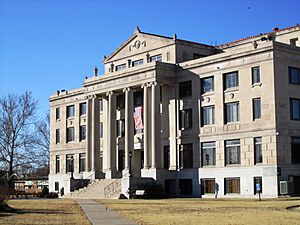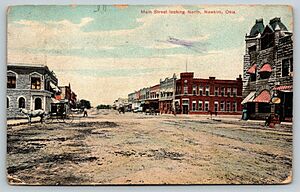Newkirk, Oklahoma facts for kids
Quick facts for kids
Newkirk, Oklahoma
|
|
|---|---|

Kay County Courthouse (2010)
|
|

Location of Newkirk within Oklahoma
|
|
| Country | United States |
| State | Oklahoma |
| County | Kay |
| Government | |
| • Type | Council-manager |
| Area | |
| • Total | 1.35 sq mi (3.51 km2) |
| • Land | 1.35 sq mi (3.51 km2) |
| • Water | 0.00 sq mi (0.00 km2) |
| Elevation | 1,152 ft (351 m) |
| Population
(2020)
|
|
| • Total | 2,172 |
| • Density | 1,602.95/sq mi (619.09/km2) |
| Time zone | UTC-6 (Central (CST)) |
| • Summer (DST) | UTC-5 (CDT) |
| ZIP code |
74647
|
| Area code(s) | 580 |
| FIPS code | 40-51300 |
| GNIS feature ID | 2411246 |
| Website | Newkirk CoC |
Newkirk is a small city in Oklahoma, United States. It is the main town, or county seat, of Kay County. In 2020, about 2,172 people lived there.
Contents
Newkirk's History
The Land Run of 1893
Newkirk is located on land once known as the Cherokee Outlet. This land belonged to the Cherokee Native American tribe. In 1893, the U.S. government bought this land.
On September 16, 1893, a huge event called the Cherokee Strip Land Run took place. About 100,000 people raced to claim pieces of land. It was a wild dash to find a new home or business spot!
How Newkirk Got Its Name
Before the land run, the government had already planned a town. It was meant to be the county seat for "K" county. This town was first named Lamoreaux. It was named after Silas W. Lamoreaux, a government official.
On the first day of the land run, about 5,000 people claimed land in and around Lamoreaux. People could claim two town lots. One lot was for a home and one for a business. Farmers could claim 160 acres in rural areas.
Soon, many people left, and the population dropped to about 2,100. The town leaders wanted to change the name to Santa Fe. But the railroad company said no, because other places were already called Santa Fe. So, on November 8, 1893, the town was officially named Newkirk.
Building the Town
In 1901, a big fire destroyed many wooden buildings in downtown Newkirk. But the town quickly rebuilt. They used strong, yellow limestone from a quarry nearby. This made the new buildings look grand and lasting.
Newkirk's downtown area is now a historic district. It was added to the National Register of Historic Places in 1984. This means it's an important place with a lot of history.
Becoming the County Seat
After Oklahoma became a state in 1907, three towns wanted to be the county seat: Newkirk, Blackwell, and Ponca City. An election was held in 1908. Newkirk won by a small number of votes!
The first county courthouse was a wooden building built in 1894. It later burned down. A new, stronger Kay County courthouse was built in 1926.
Newkirk Today
In 1992, Newkirk was the first small town to win the Oklahoma Main Street Award. This award recognizes towns that work to improve their downtown areas.
Newkirk was also mentioned in the movie Twister. A drive-in movie scene in the film was set in Newkirk. However, it was actually filmed in a different town called Guthrie.
The Kay County Courthouse, built in 1926, is almost 100 years old. In 2020, a new building called the Annex was added. This helped fix problems like a leaky roof and old pipes in the original courthouse. Now, the old courthouse is mainly used for the court system. Other county offices moved to the new Annex.
Where is Newkirk?
Land and Nature
Newkirk is on mostly flat land. There are no big rivers nearby. It sits where two different types of land meet: the Central Great Plains and the Flint Hills.
West of Newkirk, the Great Plains have rich farmland. Farmers grow crops like wheat and soybeans. They also raise cattle. East of Newkirk, the Flint Hills are more rocky. This area is mostly used for cattle ranching.
The land is mostly prairie, which means it's covered in grasses. But along streams, you can find forests. These forests have trees like cottonwood, oak, and elm. You can also see lots of wildlife, such as deer, turkey, and quail.
Nearby Places
Newkirk is about 8 miles (13 km) south of the Kansas border. The Kaw Native American tribe has a casino and other buildings about 1 mile (1.6 km) east of town.
The Arkansas River is about 6 miles (9.7 km) east of Newkirk. A bridge crosses the river near the top of Kaw Lake. Near the river, archaeologists found old villages of the Wichita Indian tribe. These villages were from the 1700s.
East of the river is a quiet area with large ranches. Locals call this area "The Osage." This is because it's near Osage County and the Osage Native American tribe.
The Washunga cemetery, belonging to the Kaw Indians, is 2 miles (3.2 km) north of Newkirk. It was moved there to keep it safe when Kaw Lake was created. The Chilocco Indian Agricultural School, which is now closed, is about 7 miles (11 km) north.
Newkirk's Climate
Newkirk has a climate with big changes in temperature. In January, the average low temperature is about 20 °F (-7 °C). In July, the average high temperature is about 92 °F (33 °C). Sometimes, winter temperatures can drop below zero. Summer days can often reach 100 °F (38 °C).
Newkirk gets about 37 inches (94 cm) of rain each year. May and June are usually the wettest months. December, January, and February are the driest. Tornadoes are common in this part of Oklahoma. However, Newkirk has never had major damage from a tornado.
Newkirk's Population
| Historical population | |||
|---|---|---|---|
| Census | Pop. | %± | |
| 1900 | 1,754 | — | |
| 1910 | 1,992 | 13.6% | |
| 1920 | 2,533 | 27.2% | |
| 1930 | 2,135 | −15.7% | |
| 1940 | 2,283 | 6.9% | |
| 1950 | 2,201 | −3.6% | |
| 1960 | 2,092 | −5.0% | |
| 1970 | 2,173 | 3.9% | |
| 1980 | 2,413 | 11.0% | |
| 1990 | 2,168 | −10.2% | |
| 2000 | 2,243 | 3.5% | |
| 2010 | 2,317 | 3.3% | |
| 2020 | 2,172 | −6.3% | |
| U.S. Decennial Census | |||
In 2000, there were 2,243 people living in Newkirk. About 25% of the people were under 18 years old. The average age was 39 years.
Economy
The main way people in Newkirk make a living is through farming.
Notable People
- Nelson T. Johnson was a very important person. He was born in Washington, D.C., but grew up in Newkirk. He became the United States ambassador to China from 1935 to 1941. He was also ambassador to Australia from 1941 to 1945.
- Richard E. Killblane is an author and military historian. He went to school in Newkirk from 1962 to 1969.
See also
 In Spanish: Newkirk (Oklahoma) para niños
In Spanish: Newkirk (Oklahoma) para niños



